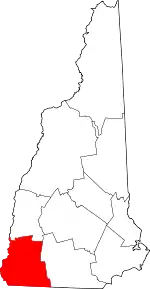Jaffrey, New Hampshire
Jaffrey is a town in Cheshire County, New Hampshire, United States. The population was 5,457 at the 2010 census.[1]
Jaffrey, New Hampshire | |
|---|---|
Town | |
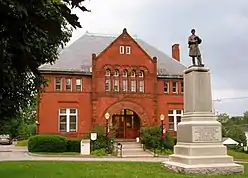 Clay Library | |
 Seal | |
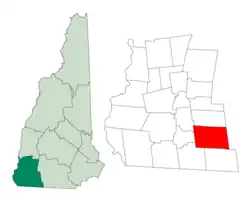 Location in Cheshire County, New Hampshire | |
| Coordinates: 42°48′50″N 72°01′23″W | |
| Country | United States |
| State | New Hampshire |
| County | Cheshire |
| Incorporated | 1773 |
| Villages | Jaffrey Jaffrey Center |
| Government | |
| • Board of Selectmen | Franklin W. Sterling, Chair John Belletete Kevin Chamberlain |
| • Town Manager | Jon Frederick |
| Area | |
| • Total | 40.0 sq mi (103.7 km2) |
| • Land | 38.3 sq mi (99.2 km2) |
| • Water | 1.7 sq mi (4.5 km2) 4.32% |
| Elevation | 991 ft (302 m) |
| Population (2010) | |
| • Total | 5,457 |
| • Density | 140/sq mi (53/km2) |
| Time zone | UTC-5 (Eastern) |
| • Summer (DST) | UTC-4 (Eastern) |
| ZIP code | 03452 |
| Area code(s) | 603 |
| FIPS code | 33-38500 |
| GNIS feature ID | 0873633 |
| Website | www |
The main village in town, where 2,757 people resided at the 2010 census,[1] is defined as the Jaffrey census-designated place (CDP) and is located along the Contoocook River at the junction of U.S. Route 202 and New Hampshire routes 124 and 137.
History
First granted by the Massachusetts General Court in 1736 to soldiers from Rowley, Massachusetts, returning from the war in Canada, the town was known as Rowley-Canada. In 1749, the town was re-chartered by the Mason proprietors as Monadnock No. 2, sometimes called Middle Monadnock or Middletown.[2] It was one of the first towns established following the Masonian proprietors' purchase of undivided lands under the claim.
Settled about 1758,[3] the town was regranted in 1767. It would be incorporated in 1773 by Governor John Wentworth, and named for George Jaffrey, member of a wealthy Portsmouth family.[2] Jaffrey's son was a life trustee of Dartmouth College, and designer of the official college seal. The Contoocook River provided water power for mills. Village prosperity would be expressed in fine early architecture, including the Town Meetinghouse, built in 1775.
Beginning in the 1840s, the area's scenic beauty attracted tourists, and several summer hotels were built at the base of Mount Monadnock, enduringly popular with hikers. Some who scaled the summit were Ralph Waldo Emerson, Henry David Thoreau and Rudyard Kipling. The experience inspired Emerson in 1845 to write the poem, Monadnoc.
Jaffrey was the setting for a 1950 biography by Elizabeth Yates entitled Amos Fortune, Free Man, winner of the 1951 Newbery Medal. Amos Fortune was an African-born slave who purchased his freedom and that of his wife, and established a tannery in the village. He is buried in the local cemetery, together with bandbox craftswoman Hannah Davis, and author and summer resident Willa Cather.
Jaffrey was the inspiration for a chapter in Parliament of Whores by P. J. O'Rourke, who was a resident for several years.
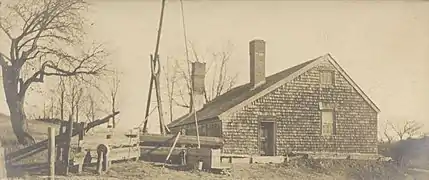 Old Baker Home, which was the oldest house in Jaffrey in 1905
Old Baker Home, which was the oldest house in Jaffrey in 1905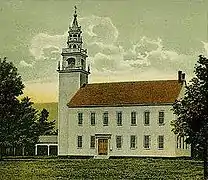 Town Hall in 1905
Town Hall in 1905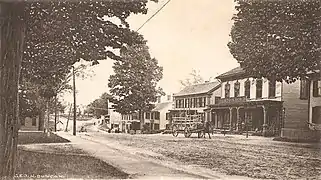 Main Street in 1907
Main Street in 1907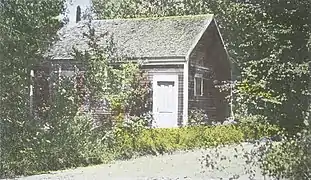 Old schoolhouse c. 1915
Old schoolhouse c. 1915
Geography
According to the United States Census Bureau, the town has a total area of 40.0 square miles (104 km2), of which 38.3 sq mi (99 km2) is land and 1.7 sq mi (4.4 km2) is water, comprising 4.32% of the town. Jaffrey village is in the eastern part of the town, and the smaller village of Jaffrey Center is near the town center.
Thorndike Pond is in the north, and Contoocook Lake is on the southern boundary. Mount Monadnock, elevation 3,165 feet (965 m) above sea level and the highest point in Jaffrey, is in the northwest. Jaffrey lies mostly within the Merrimack River watershed, via the Contoocook River in the eastern part of the town, with the northwest corner of town lying in the Ashuelot River watershed, part of the larger Connecticut River watershed.[4]
Adjacent municipalities
- Dublin (north)
- Peterborough (northeast)
- Sharon (east)
- Rindge (south)
- Fitzwilliam (southwest)
- Troy (west)
- Marlborough (northwest)
Demographics
| Historical population | |||
|---|---|---|---|
| Census | Pop. | %± | |
| 1790 | 1,235 | — | |
| 1800 | 1,341 | 8.6% | |
| 1810 | 1,336 | −0.4% | |
| 1820 | 1,339 | 0.2% | |
| 1830 | 1,354 | 1.1% | |
| 1840 | 1,411 | 4.2% | |
| 1850 | 1,497 | 6.1% | |
| 1860 | 1,453 | −2.9% | |
| 1870 | 1,256 | −13.6% | |
| 1880 | 1,267 | 0.9% | |
| 1890 | 1,469 | 15.9% | |
| 1900 | 1,801 | 22.6% | |
| 1910 | 1,895 | 5.2% | |
| 1920 | 2,303 | 21.5% | |
| 1930 | 2,485 | 7.9% | |
| 1940 | 2,879 | 15.9% | |
| 1950 | 2,911 | 1.1% | |
| 1960 | 3,154 | 8.3% | |
| 1970 | 3,353 | 6.3% | |
| 1980 | 4,349 | 29.7% | |
| 1990 | 5,361 | 23.3% | |
| 2000 | 5,476 | 2.1% | |
| 2010 | 5,457 | −0.3% | |
| 2017 (est.) | 5,259 | [5] | −3.6% |
| U.S. Decennial Census[6] | |||
As of the census of 2010, there were 5,457 people, 2,234 households, and 1,451 families residing in the town. There were 2,547 housing units, of which 313, or 12.3%, were vacant. 160 of the vacant units were for seasonal or recreational use. The racial makeup of the town was 96.2% white, 0.4% African American, 0.2% Native American, 1.2% Asian, 0.04% Native Hawaiian or Pacific Islander, 0.3% some other race, and 1.7% from two or more races. 1.6% of the population were Hispanic or Latino of any race.[7]
Of the 2,234 households, 30.9% had children under the age of 18 living with them, 48.4% were headed by married couples living together, 11.1% had a female householder with no husband present, and 35.0% were non-families. 28.6% of all households were made up of individuals, and 10.5% were someone living alone who was 65 years of age or older. The average household size was 2.41, and the average family size was 2.95.[7]
In the town, 24.0% of the population were under the age of 18, 7.8% were from 18 to 24, 23.2% from 25 to 44, 29.6% from 45 to 64, and 15.3% were 65 years of age or older. The median age was 41.5 years. For every 100 females, there were 93.5 males. For every 100 females age 18 and over, there were 91.4 males.[7]
For the period 2011-2015, the estimated median annual income for a household was $56,618, and the median income for a family was $73,564. Male full-time workers had a median income of $50,138 versus $39,434 for females. The per capita income for the town was $27,689. 15.0% of the population and 6.5% of families were below the poverty line. 28.3% of the population under the age of 18 and 15.9% of those 65 or older were living in poverty.[8]
School system
Jaffrey, along with the town of Rindge, forms the Jaffrey-Rindge Cooperative School District, also known as SAU 47. The public schools in the town are Jaffrey Grade School (grades K–5), Jaffrey-Rindge Middle School (6–8), and Conant High School (9–12). There is also a private high school, Victory High School (9–12).
Master plan
As with many small rural towns in New England, Jaffrey entered the 21st century grappling with the issues of how to cope with increased population growth and development pressures. Both for tourism and for quality of life of its residents, open undeveloped land is an important component of the town's attractions. In the 2007 update to its Master Plan, the town specifically cites a desire to preserve open space and rural character.
Notable people
- Laban Ainsworth, early minister
- Lucy Barnes, writer
- Vannevar Bush, engineer, inventor, and scientist
- Willa Cather, author
- Francis Joseph Christian, retired auxiliary bishop, Diocese of Manchester
- Amos Fortune, early resident, tanner, and subject of Elizabeth Yates' book Amos Fortune, Free Man
- Fannie Hillsmith, painter
- Alfred B. Kittredge, US senator from South Dakota
- Talcott Parsons, sociologist
- Jedediah Sanger, operated a farm, store, tavern 1770s-1780s
- Levi Spaulding, missionary
- Oliver L. Spaulding, Civil War general and politician
References
- United States Census Bureau, American FactFinder, 2010 Census figures. Retrieved March 23, 2011.
- Coolidge, Austin J.; John B. Mansfield (1859). A History and Description of New England. Boston, Massachusetts: A.J. Coolidge. pp. 536–537.
coolidge mansfield history description new england 1859.
- Cutter, Daniel B., M.D. (1881). History of The Town of Jaffrey: The Masonian Charter to the Present Time, 1749–1880. Concord, N.H.: Republican Press Association. p. 32.
jaffrey, New Hampshire founded.
- Foster, Debra H.; Batorfalvy, Tatianna N.; Medalie, Laura (1995). Water Use in New Hampshire: An Activities Guide for Teachers. U.S. Department of the Interior and U.S. Geological Survey.
- "Annual Estimates of the Resident Population: April 1, 2010 to July 1, 2017 (PEPANNRES): Minor Civil Divisions – New Hampshire". Archived from the original on February 13, 2020. Retrieved November 14, 2018.
- "Census of Population and Housing". Census.gov. Retrieved June 4, 2016.
- "Profile of General Population and Housing Characteristics: 2010 Census Summary File 1 (DP-1): Jaffrey town, Cheshire County, New Hampshire". U.S. Census Bureau, American Factfinder. Archived from the original on February 13, 2020. Retrieved October 26, 2017.
- "Selected Economic Characteristics: 2011-2015 American Community Survey 5-Year Estimates (DP03): Jaffrey town, Cheshire County, New Hampshire". U.S. Census Bureau, American Factfinder. Archived from the original on February 13, 2020. Retrieved October 26, 2017.
